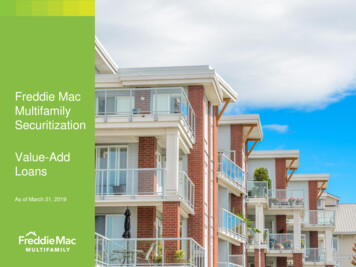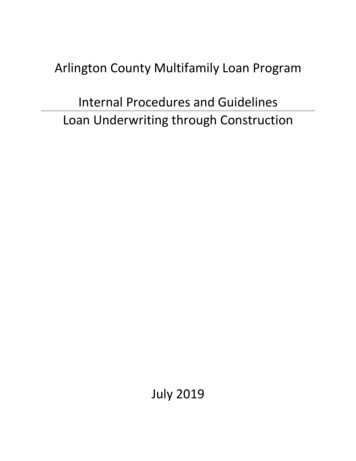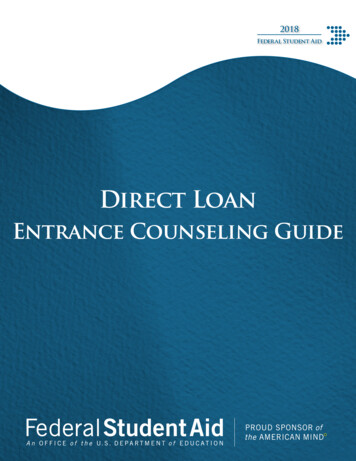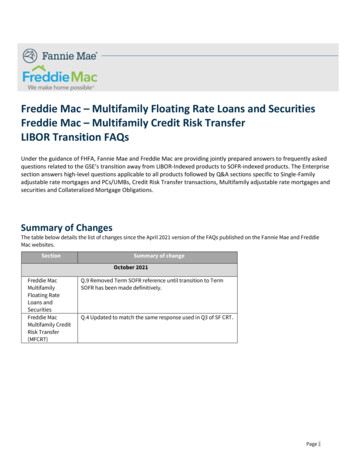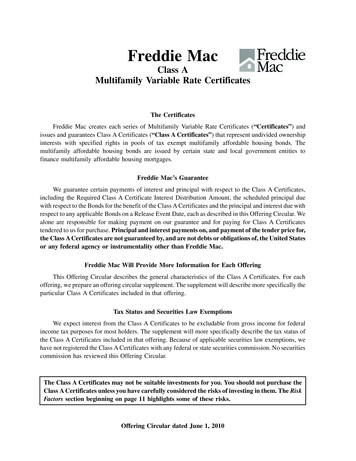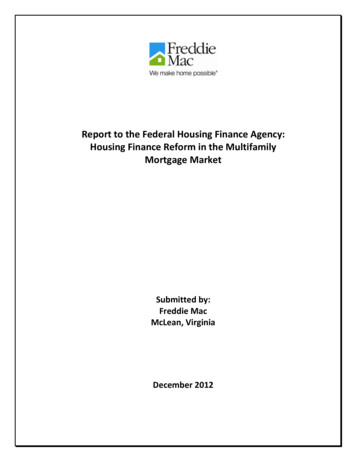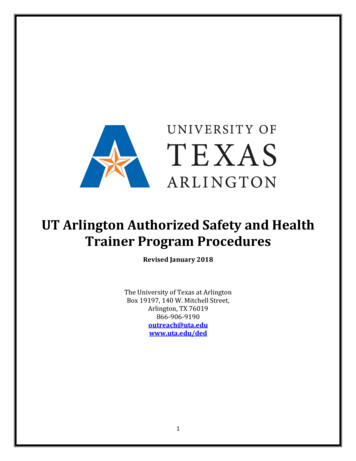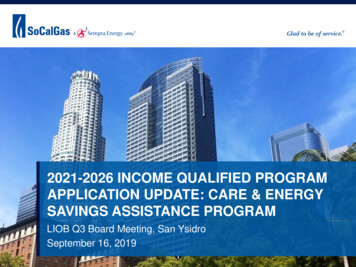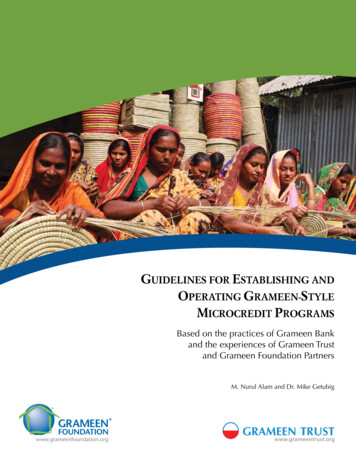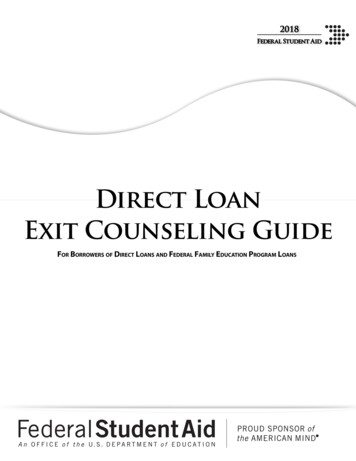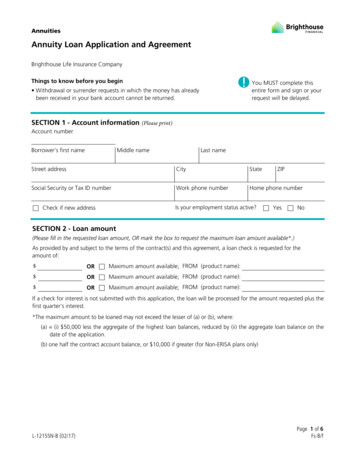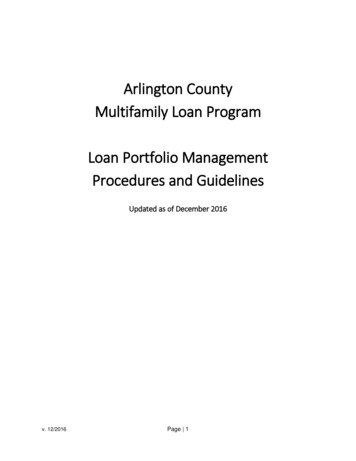
Transcription
Arlington CountyMultifamily Loan ProgramLoan Portfolio ManagementProcedures and GuidelinesUpdated as of December 2016v. 12/2016Page 1
Arlington County Multifamily Loan ProgramLoan Portfolio Management Procedures and Guidelines1. Introductiona.b.c.Program mission and goalsFunding Sources – AHIF, HOME, CDBGLoan Structure – definition of residual receipt2. Loan Underwriting and Approval Processa.Affordable Housing Master Plan Goals, Objectives and Policiesb.Affordable Housing Investment Fund (AHIF) Guidelines & Criteria andNotice of Funding Availability (NOFA)c.Loan Underwriting Processd.Calculating and Filling the Gap3. Financial Proceduresa.Fund Disbursement (PO v. manual warrant)b.Requesting new account code combinations4. Administrative Procedures – Loan Filinga.Loan Agreement and Attachmentsb.Deed of Trust, Deed of Declarations of Restrictive Covenants andPromissory Notec.ATRACKd.Record Retention5. Annual Requirements for Borrowersa.Annual Operating Budgetsb.Annual Audited Financialsc.Insurance Certificates6. Annual Payments, Repayments and Pay-offsa.Making a Deposit/Receiving a Wire7. Oversight and Loan Performance Assessmenta.Annual Financial Monitoring Overviewb.Annual Operating Budget Reviewc.On-Site Financial Monitoring Reviewd.Compliance / Tenant Income Reviewi. Addressing Noncompliancee.On-Site Unit Inspectionsv. 12/2016Page 2
f.g.i. Addressing Deficient ConditionDiscussions with Owners Throughout the YearMonitoring Reports8. Loan Re-Structuringa.Tools for Underperforming Propertiesb.Identifying Propertiesc.Process9. Conclusion10. Exhibits1. Affordable Housing Master Plan Goals and Objectives2. Affordable Housing Investment Fund (AHIF) Project Funding Guidelines3. Sample Operating Budget Report4. Compliance / Affordability Monitoring Procedures5. Financial / Loan Portfolio Monitoring Reportv. 12/2016Page 3
INTRODUCTIONProgram mission and goalsThe Affordable Housing Investment Fund (AHIF) is the County’s main financing program foraffordable housing development. Since its creation in 1988, AHIF has helped to create themajority of Arlington’s more than 7,000 approved affordable rental units that benefit low- andmoderate-income households. In conjunction with the Affordable Housing Ordinance, thisrevolving loan fund provides incentives for developers through low-interest loans for newconstruction, acquisition and rehabilitation of affordable housing. Since 2000, the County hasoriginated more than 200 million in loans for affordable units.As stated in the Arlington County Affordable Housing Master Plan, adopted by the County Boardin September 2015, Arlington County Policies Goals for AHIF are as follows: 1.1.1 Encourage the construction and preservation of affordable rental housing throughland use/zoning policy, financial and technical assistance. 1.1.7 Remove barriers to the production of moderately-priced rental housing, includingnon-subsidized housing. 1.2.2 Encourage production and preservation of family-sized (e.g. 3 bedroom)moderately-priced ownership units. 2.3.3 Prevent homelessness through safety net supports and social services to enableresidents to maintain their housing. 2.5.3 Maintain a sufficient supply of committed affordable housing that is accessible topersons with physical and sensory disabilities.Funding Sources – AHIF, HOME, CDBGThe County’s Affordable Housing Investment fund (AHIF) is a revolving loan fund that providesgap financing to developers that preserve or build Committed Affordable Housing (CAF) units inthe county. AHIF is the key mechanism through which the County funds the construction andredevelopment of housing affordable to low-income renters. AHIF also supports housing thatcombines housing and services for vulnerable populations.AHIF is funded by several sources; developer contributions obtained through the AffordableHousing Ordinance; general revenue; AHIF loan repayments; federal Community DevelopmentBlock Grant (CDBG) and HOME Investment Partnership (HOME) entitlement funds; and a portionof property recordation fees. Between FY2010 and FY2014, AHIF received an average of 8million in local funding annually. The AHIF is designed to allow for flexibility in loan termsdepending on the characteristics of the affordable housing project (e.g. incomes targeted,affordability term) and conditions in the market.Loan StructureThe County’s Affordable Housing loans are structured in a variety of ways. County staff willanalyze many different aspects of the project including: cost, affordability restrictions, currentv. 12/2016Page 4
tenant income, size, location, type of construction or amount of renovations, etc. in order toprovide funding that leverages as much other financing as possible. However, County staff alsotries to balance all project aspects with financial feasibility, so that it is not overburdened withunrealistic financing terms.The majority of the loans for affordable housing projects in the County’s loan portfolio areresidual receipt or cash flow loans. The loans are usually long term loans (60 years), at a belowmarket interest rate (less than 3%) and provide annual payment to the County if and when theproject has positive cash flow. Cash flow is defined through the loan agreement and thencertified through the project’s annual audited financial statements. The balance of the loan isdue at the end of the term or upon sale or transfer of the property unless it is refinanced orredeveloped with County Board approval and retains its CAFs.LOAN UNDERWRITING AND APPROVAL PROCESSAffordable Housing Master Plan Goals, Objectives and PoliciesIn September, 2015, the Arlington County Board adopted the Affordable Housing Master Planwhich is an element of the Arlington County Comprehensive Plan. The Affordable HousingMaster Plan (AHMP) was developed as the County’s long-range vision for addressing housingneeds through 2040, and defines the County’s housing policy. The Plan will be reviewed andrevised as necessary at least once every five years to account for changing conditions within andbeyond the County.The Affordable Housing Goals and Objectives are used for guidance as the County invests itsAHIF, HOME and CDBG funds in housing projects that contain CAFs. The Affordable HousingGoals, Objectives and Policies of the Affordable Housing Master Plan are listed in Exhibit 1.Affordable Housing Investment Fund (AHIF) Project Funding Guidelinesand Notice of Funding Availability (NOFA)AHIF Project Funding Guidelines and Process (Prior to FY2018)For many years, the Development Section of the Housing Division has reviewed proposals andfunding requests for affordable housing projects throughout the County on a rolling basis withthe Affordable Housing Investment Fund (AHIF) Project Funding Guidelines (see Exhibit 2). TheAHIF Project Funding Guidelines guide the review and evaluation of AHIF, HOME, and CDBG loanrequests for affordable housing projects in Arlington County. They provide a basis for fundingrecommendations made by the Arlington County Housing Division to the County Manager andCounty Board.v. 12/2016Page 5
Projects meeting certain goals and objectives of the County are invited to submit acomprehensive application, and the Development Section staff begins a thorough reviewprocess. The process includes: underwriting the requested loan; negotiating with thedeveloper/owner on all aspects of the project (financing, number and type of affordable unit,etc.); working with various stakeholders such as the Housing Commission and theTenant/Landlord Commission; and working with the County Manager’s Office if the project wasto move forward in seeking approval of the project from the County Board.NOFA Process (Beginning in FY2018)Currently, the County is moving toward a Notice of Funding Availability (NOFA) process. Whilesimilar comprehensive underwriting reviews will continue, the County will be able to evaluateprojects concurrently and select projects by comparing them. The selections will form the staffrecommendations for the following fiscal year’s pipeline.Selections will be determined through an administrative process conducted by the County’sHousing Division. The Housing Development, Finance, and Community Planning teams wouldscore appropriate sections of the applications. The scores will be totaled and averaged across allstaff into a final score. Housing staff will then present the recommendations for the pipeline tothe County Managers Office. The selected applicants will be notified and staff will meet anddebrief with applicants who are not selected. There will be no appeals process.After selection, applicants will then continue the four to eight month review process includingnegotiations with the developer/owner on financing of the project, meetings that may be relatedto the planning process such as Site Plan Review Committee (SPRC) or Form Based Code AdvisoryWorking Group meetings, Planning Commission meetings, and Housing Commission meetings.At the conclusion of the review process, the application will go before the County Board for alocal fund allocation.Loan Underwriting ProcessAs described more thoroughly in Exhibit 2, the Affordable Housing Investment Fund (AHIF)Project Funding Guidelines, the Loan Underwriting Process is comprehensive and complex. Staffanalyzes the project against many competing goals and objectives such as the AffordableHousing Master Plan Goals, Project Risk and Opportunity, Project Readiness and Schedule,Capital Budget Standards, Proforma and Operating Budget Standards, and Developer/SponsorExperience. The ultimate goal of the underwriting process is to make sure that the projectconforms with all of the stated affordable housing goals of the County, assists the populationthat it is intended to serve, complies with all of the requirements of its other financing (tax creditinvestor, VHDA, etc.) and utilizes the minimum allocation from the County to accomplish thosegoals.Calculating the Loan Amount (Filling the Gap)v. 12/2016Page 6
As noted above, the Affordable Housing Investment Fund (AHIF) Project Funding Guidelines,describes more about calculating the loan amount and funding the gap in Section III – ProjectEffectiveness and Financial Efficiency Review. Specifically, it states, “The applicant demonstratesthat it is requesting only the amount of County funds needed to fill a funding gap, without whichthe project could not go forward.” Other cost considerations discussed and factored into theamount of gap financing include: maximum leveraging, acquisition costs at or below market,construction costs are consistent with other similar projects, developer fees and other soft costsare appropriate by industry standard, there is a developer contribution and that the requestedCounty funds are proportional to the Total Development Costs (TDCs). Every factor of theproject is analyzed for its effect on the cost of the project and whether the costs are warranted.FINANCIAL PROCEDURESArlington County has many established controls and procedures in order to ensure timely,accurate and well-documented disbursements and conversely, repayments for the loans in itsportfolio. Financial information is critical in monitoring and reviewing the loan portfolio and thestatus of the many properties. The information below demonstrates the financial processfollowed for properties.Fund Disbursement (P.O. versus Manual Warrant)Once authorized by the County Board, Arlington County funds are most commonly disbursedthrough a purchase order or a manual warrant. Both disbursement vehicles require evidence ofBoard approval (typically a board report), demonstration that funds are available (e.g., currentaccount balance from the County’s PRISM system), a signed agreement or contract, andbanking/wire information for the receiving organization. Purchase orders also require that therecipient be established as a “supplier” in the County’s payment system, which requiressubmission of a W-9 for the organization receiving payment.Typically, manual warrants are used for one-time disbursements, which makes manual warrantsan appropriate vehicle for settlements of County loans to multifamily (or single family)development projects. Meanwhile, purchase orders work well when the County anticipatesmultiple disbursements over a longer period of time. For instance, if the County is disbursing(federal) funds on a reimbursement basis, e.g., as certain construction milestones are complete,a purchase order may be a more appropriate vehicle. Purchase orders are also used for ourTenant Assistance Fund (TAF) contracts to reimburse developers for rental assistance paid onbehalf of tenants.Requesting New Account Code CombinationsAccount Code Combinations (ACCs) in the County’s PRISM system may track revenue or expensesand each include six segments:v. 12/2016Page 7
[Fund].[Natural Account].[Cost Center].[Project].[Source of Funds].[Task]When funds are disbursed through a purchase order, staff set up a project-specific expenseaccount code to help track funds disbursed to-date and remaining funds authorized. Similarly,when County loans start repaying, having project-specific revenue codes help staff track paymenthistory by project.New ACC segments may only be established by submitting a request to the County’s Chart ofAccounts (COA) email. This central process helps control the number of new segments createdand prevent duplicate requests. Once individual segments are created, segments in the County’snon-departmental fund (101) may be assembled to create a complete ACC either by sending arequest to the County’s COA email or through the County’s Department of Management andFinance. Meanwhile, if the new ACC is in fund 206 (or another department-specific fund), staffwith the proper permissions may create the new ACC using a module in PRISM. ACCs that are nolonger in use may be “end-dated” to make them inactive.ADMINISTRATIVE PROCEDURES – LOAN FILINGThe County has instituted several processes to ensure that the loan agreement and other legaldocuments are appropriately distributed, scanned, filed and retained. The loan agreement is acomprehensive document that thoroughly describes all aspects of the project and includes typical legaldocuments for publicly funded affordable housing projects such as the Deed of Trust, the PromissoryNote, the Deed of Declaration of Restrictive Covenants, and the Subordination Agreement, if applicable.Loan Agreement and AttachmentsAfter a project has gone to settlement, and appropriate financial accounts have been establishedas described in the section above, the agreement and attachments are scanned and placed inthe required electronic and hardcopy files. The County retains both a hardcopy and a scannedelectronic copy of the document with all applicable attachments. The hardcopy is filed with theAsset Manager and is reviewed and referred to several times throughout the year. The scannedelectronic copy is filed on the County’s L drive in the Housing Division folder. All projects andloans have separate folders to contain all of the electronic documents including project analysisand other supporting and historical documentation.Deeds of Trust, Deeds of Declaration of Restrictive Covenants and Promissory Notes– AdditionalFor any project that receives funding from the County, the County will execute a Deed of Trust, aDeed of Declaration of Restrictive Covenants and a Promissory Note in addition to the otherdocuments listed in other sections. The Deed of Trust and Deed of Declaration of RestrictiveCovenants will be recorded by the owner/borrower immediately after settlement and copies ofthe recorded documents will be returned to the County. The originally signed documentsv. 12/2016Page 8
including the Deed of Trust, Deed of Declaration of Restrictive Covenants and Promissory Noteare filed in a locked file cabinet in the Housing Division’s file room. This ensures that the Countywill have at least one, full original copy of the agreement with all of the attachments.ATRACKThe Arlington County Apartment Tracker (ATRACK) is a custom internet-based system that allowsthe County to track all apartment complexes in the County, all CAFs and all of our loans toowner/developers. The Asset Manager and Development Specialist work together to set up newprojects and/or new financing after settlement. Once the project is listed, the financialinformation including interest accruals, repayments, changes to loan terms, etc., is updated andreviewed by the Asset Manager. ATRACK is able to calculate and provide interest accruals, loanbalances, number of affordable units and other comprehensive reports that staff can use foranalysis or to provide to internal or external stakeholders.Record RetentionArlington County retains records for a minimum of seven (7) years and a variety of maximumamounts of time depending on the requirements set forth in the agreement or legal documentsuch as: Loan Agreement with applicable attachments, Recorded Deed of Trust, OriginalPromissory Note – for seven (7) years PLUS the term of the loan or the payoff date. Deed of Declaration of Restrictive Covenants – for seven (7) years PLUS the term of thehousing affordability period.ANNUAL REQUIREMENTS FOR BORROWERSArlington County requires several annual submittals for CAF properties in its portfolio. Thecombination of these submittals in addition to annual project monitoring and intermittent calls,discussions, and emails, allows the County to obtain a comprehensive view of the status of theproperty. Because of the small size of Arlington and the relatively small size of its loan portfolio,staff has the opportunity for property visits, meetings with management, and other options forfollow-up that assist in a timely gathering of information.Annual Operating BudgetsBorrowers/Owners must submit to County Staff proposed operating budgets for each propertyapproximately 6-8 weeks prior to the beginning of the fiscal year of the property and as notedper each property’s agreement. The operating budgets are reviewed thoroughly and are alsoreviewed (1) as an individual property and (2) compared to other properties in Arlington.Initially, staff reviews the individual property’s budget against the prior year budget. The firstaspect of the budget that is analyzed are the rents/income:v. 12/2016Page 9
What is the affordability makeup of the property (i.e. how many 50% units, 60% units,etc.)?Is the owner establishing rents at the maximum rent allowed? If no, why not?Are there any other sources of income and are they significant (i.e. cell phone towerrental)?What vacancy rate is being applied? Is it consistent with the previous year? Why or whynot?Second, operating expenses are reviewed and noted: What are the per unit operating costs? What costs are listed under the operating line item? What fees are included in the operating costs (i.e. management fees, asset managementfees)? Are these operating costs consistent with the previous year? How is the property budgeting for any capital needs (i.e. unit turnover or greater capitalneed) – is it part of the operating budget or being paid for out of replacement reserve?Finally, both income and expenses are compared to other similar properties in Arlington toestablish if the budget is comparable to other properties of similar size and location. If thebudget is outside a normal range (too high or too low), the borrower/ Owner will be contactedand asked to explain the discrepancy.Staff will ultimately approve or disapprove the annual budget. If the budget is approved, theBorrower/ Owner uses it to operate the property for that year. However, if there are unforeseencosts or circumstances, the annual budget can be reviewed and amended throughout the yearby working with County staff. If the budget is not submitted or approved by the beginning of thefiscal year for the property, the Borrower/ Owner can either (1) utilize the previous year’sapproved budget as its guide or (2) work with County staff and make adjustments so that currentyear’s budget is approved.Annual Audited Financial StatementsBorrowers / Owners must submit to County staff annual certified audited financial statements.These statements provide an opinion about whether the information included in the financialstatements are accurate as well as detailed financial information about the property. It isthrough the audited statements that County staff is able to review overall cash balances, debtand liens on the property (secured and unsecured), statements of profit and loss, and cash flowavailable for a potential loan repayment for the County. The audited financial statements arealso usually submitted with the payments.Insurance CertificatesBorrowers/Owners must submit insurance Certificates, listing the County as additional insured,on an annual basis. The insurance requirements are listed in each agreement but may includev. 12/2016Page 10
and not be limited to Builder’s Risk, General Liability, Automobile Liability, and Property & FireInsurance. The type of insurance and coverage amount is detailed in each agreement. Staffreviews the insurance requirements on an annual basis, and typically, an insurance certificate foreach property will be sent to the County listing the insurance and coverage amount.ANNUAL REPAYMENTSMaking a Deposit / Receiving a WireTypically, Borrowers/Owners submit annual residual receipt payments along with annualfinancial statements. Staff will concur that the check or wire matches what is noted in theannual financial audits and that there are no outstanding questions with the annual audit. Staffwill also confirm that the deposit or wire is deposited in the correct account via the accountingcodes that are unique to each project and each loan and/or funding source.OVERSIGHT ANDLOAN PERFORMANCE ASSESSMENTAnnual Financial Monitoring OverviewArlington County Housing staff monitors projects in its loan portfolio as well as the owners ofthese projects annually. Desktop reviews are completed for all projects and include review andapproval of the annual operating budgets, review and acceptance of the annual auditedfinancials completed by third-party auditors, and review and completion of audit confirmationsfor various other lenders of the projects. Site visits and in-person meetings are conducted on anannual basis for certain projects and owners. The County currently has approximately 35projects in its loan portfolio.Together, AHC, Inc. and APAH are owner/developers of 65% of the County’s portfolio. Becauseof this, the County intends to complete desktop reviews and on-site, in-person meetings for AHCand APAH every year. This allows for more comprehensive reviews, discussions, andunderstanding of the properties and the property management as well as the ability to workthrough any challenges that arise before they become more complex and difficult to resolve,especially if they represent trends in the larger portfolio.The other owners and properties in the County’s loan portfolio are as follows: Paradigm – Historic Ballston Park (at Buckingham Village), The Madison CPDC – The Larkspur Silverwood – Monterey Apartments Wesley – Pierce Queen (Union on Queen), William Watters Telesis – Scattered Site (Ft. Myer I, Ft. Myer II, Garfield Gardens), Buckingham Village 3 Retirement Housing Foundation – The Carlin Views at Clarendon - vPointv. 12/2016Page 11
Culpepper Gardens – Culpepper Gardens IFor these properties, the County completes annual desktop reviews of the operating budgets,audited financials and any other applicable correspondence or information. The County intendsto complete on-site, in-person meetings for these properties every two to three years dependingon information gathered during the desktop review. If the property is performing well, theowner is in compliance with all of the requirements of the agreement, and the County hasreceived timely loan repayments, the property is considered to be in good-standing and will bemonitored on-site and in-person every three years.Annual Operating Budget ReviewThe County completes reviews of the annual operating budgets for each property in its loanportfolio and some others that have a vested County interest (leased land, etc.). The operatingbudgets are reviewed and compared against previous years’ budgets for the same property,previous years’ budgets for similar properties and current budgets for similar properties to noteany discrepancies or trends in the operations of a property with CAFs.Specific items that are reviewed are as follows: Income – rents for the specific units, rents are maximum allowed under tax credit orother funding source rules (also received from Compliance Manager), other income,vacancy rates Expenses – administrative costs, management fee, utility expenses, maintenanceexpenses, property and other taxes, other fees Debt Service – first mortgage, other debtWith restrictions on household income and rent charged to residents, the budgets for theproperties in the County’s portfolio are relatively stable with only modest increases in incomeand more moderate increases in expenses for any given year. However, if it is a mixed-incomeproperty, income can be more variable since there are not any restrictions on rent for certainunits. Conversely, some of Arlington’s mixed-income properties also have the highest expensessince owners are constantly marketing and needing to upgrade property features to staycompetitive in the Arlington County rental market.Staff provides owners with a report describing the property, the operating budget compared toothers, the loan balance(s), and any other aspect of the budget that may be important tohighlight. A copy of a sample report is attached as Exhibit 3.On-Site Financial Monitoring ReviewAs discussed above, County staff completes on-site monitoring reviews of AHC and APAHannually since they are owners or developers of more than 65% of the County’s portfolio. Staffprepares by reviewing information on all of the properties, and then monitoring visits arescheduled with a goal to focus on one or two properties. Those AHC, APAH and other ownerproperties are selected based on a variety of circumstances such as: increase or decrease inincome and/or expenses, decrease in residual receipt payments, change in management, closev. 12/2016Page 12
to Year 15 for a tax credit deal, and other circumstances that may affect the property andultimately, the tenants.Compliance / Tenant Income ReviewCommitted Affordable rental units (CAFs) are monitored for compliance with affordabilityagreements; this includes rent amounts and the verifications of incomes of tenants. Most CAFsare monitored by two separate sets of compliance inspectors, because a majority of CAFproperties have support from both the County and the Virginia Housing Development Authority’sLow-Income Housing Tax Credit (LIHTC) program; both of these conduct monitoring via sitevisits, reviews of reporting, and physical unit inspections.Those CAF properties which are not monitored by any other agency are monitored with a sitevisit from the Housing Division’s Compliance Officer at least once per year. CAF properties whichare monitored by the LIHTC program are typically monitored with a site visit from theCompliance Officer every other year. All properties submit an occupancy report annually listingunits, rent amounts, households, and household incomes.Addressing NoncomplianceIn any cases in which rents charged are found to exceed allowed maximums, changes are maderetroactively and credits are extended to tenants. In any cases in which incomes have not beenverified for more than 12 months, verifications must be completed in 60 days.Any uncorrected noncompliance with an affordability agreement is liable to be addressed by theCounty Attorney’s Office. Affordability agreements reserve for the County the right to action orproceeding at law or in equity to require Borrower to perform its obligations and covenants.For CAFs which have been established by Site Plan agreements, uncorrected noncompliancewould be violations of the Site Plan, which ultimately can result in tickets and fines for thedeveloper.Detailed explanations of monitoring procedures are in the document “Monitoring of CommittedAffordable Rental Units,” Exhibit 4.On-Site Unit InspectionsCommitted Affordable rental units (CAFs) are inspected concurrently with scheduled ComplianceReviews. As noted above, physical unit and common area inspections are conducted by multiplevested agencies including the Virginia Housing Development Authority (VHDA); the HousingChoice Voucher (section 8) Program; and in some cases the Dept. of Housing and UrbanDevelopment’s (HUD) Real Estate Assessment Center’s (REAC) inspection teams. Wheneverpossible, efforts are made during scheduling to avoid redundant inspections of the same units bymultiple agencies.CAF inspections encompass a sampling of dwelling units along with common areas includinglaundry, storage, meeting, fitness and child play areas to ensure code compliance. The Virginiav. 12/2016Page 13
Uniform Statewide Building Code (USBC) Part III- Virginia Maintenance Code (VMC) is used as theminimum standard for identifying deficient conditions.Addressing Deficient ConditionAny deficient conditions found during an inspection are reviewed with management staff at theend of the inspection. A letter of correction is drafted and delivered to management staffoutlining deficiencies; required corrective action and a timeframe for compliance (typically 30days, special circumstances up to 90 days).A re-inspection is required for any deficient conditions to confirm compliance with the VMC.However rare, if voluntary compliance is not met, the case may be referred to the CodeEnforcement Office for enforcement actions.Once compliance has been met, a letter of compliance is drafted and delivered to managementstaff. All associated paperwork is kept on file.
Arlington County Multifamily Loan Program Loan Portfolio Management Procedures and Guidelines 1. Introduction a. Program mission and goals b. Funding Sources - AHIF, HOME, CDBG c. Loan Structure - definition of residual receipt 2. Loan Underwriting and Approval Process a. Affordable Housing Master Plan Goals, Objectives and Policies b.
